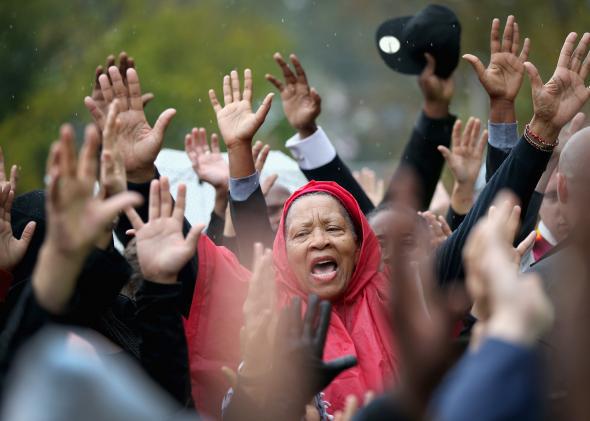In his account to investigators, Ferguson, Missouri, police officer Darren Wilson said Michael Brown charged him. Specifically, Wilson said Brown struggled for his gun during a scuffle in his police SUV and almost reached the trigger. After blocking his grab for the gun, Wilson fired two shots—hitting Brown in the hand—and fired again when, he says, Brown stopped running, turned around, and took another lunge.
On Wednesday, a new analysis of the official autopsy report—released by the St. Louis Post-Dispatch—seemed to support this account. The newspaper asked two independent experts who aren’t involved in the investigation to review the evidence. The first, St. Louis County Medical Examiner Dr. Michael Graham, says that the report “does support that there was a significant altercation at the car.” And while the report notes the lack of short-range gunpowder burns or stipple around Brown’s hands, Graham says, “Sometimes, when it’s really close, such as within an inch or so, there is no stipple, just smoke.”
One of the experts—Dr. Judy Melinek, a forensic pathologist in San Francisco—was even more certain on the autopsy’s implications. It “supports the fact that this guy is reaching for the gun, if he has gunpowder particulate material in the wound,” she said. “If he had his hand near the gun when it goes off, he’s going for the officer’s gun.” What’s more, she said that the autopsy didn’t support witnesses who claimed Brown was running away. “The wound to the top of Brown’s head would indicate he was falling forward or in a lunging position toward the shooter,” writes the St. Louis Post-Dispatch in a summary of her remarks.
But there’s a problem here. Melinek says she was misconstrued. “I’m not saying that Brown going for the gun is the only explanation. I’m saying the officer said he was going for the gun, and the right thumb wound supports that,” she later told MSNBC. “I have limited information. It could also be consistent with other scenarios. That’s the important thing. That’s why the witnesses need to speak to the grand jury and the grand jury needs to hear all the unbiased testimony and compare those statements to the physical evidence.”
That the autopsy is consistent with Wilson’s account is a godsend for the police officer. And to that end, there’s speculation that the autopsy was leaked as a prelude to news that Wilson would escape an indictment from the grand jury.
At the same time, it’s important to note the extent to which this autopsy agrees with one conducted in August by Dr. Michael Baden, former chief medical examiner for New York City. According to his autopsy, Brown was shot six times, including twice in the head. “This one here looks like his head was bent downward,” he said, referring to the wound at the top of Brown’s head. “It can be because he’s giving up, or because he’s charging forward at the officer.”
And both autopsies fit the opposing accounts from other witnesses. “[Wilson] reached out the window and tried to choke my friend. We were trying to get away, and he tried to pull my friend into the car,” said Dorian Johnson, who was with Brown, saw the whole encounter, and never claimed there wasn’t a fight at the police vehicle. The question, rather, is what precisely happened. Later, we learned of two witnesses who saw the shooting and filmed their near-instant reaction. “He had his f-ckin’ hands up,” said one of the men, echoing other reports.
The Justice Department is conducting its own autopsy, and it’s likely to fit the results of the previous ones. (It has also condemned this leak, calling it “irresponsible and highly troubling.”) Which is to say that—barring new evidence—we’re stuck with the facts we’ve had since August, none of which gives a conclusive answer to the key question in the case: Who started it? And even if it did—and even if Brown was at fault for the whole encounter—we’re still left with the other important question: Why did Wilson keep firing after Brown moved away?
At this point, any answer is tied tightly to your sympathies. Side with Michael Brown and the Ferguson protesters, and you’re likely to think Wilson overreacted or—at worst—actively abused his power. And if you support Darren Wilson, you’re just as likely to see an honest cop just defending himself from a dangerous aggressor.
Put another way, Ferguson is still thick with tension from Brown’s shooting, and if Wilson isn’t indicted, it could explode into a new round of protests. Indeed, it’s possible this is why Gov. Jay Nixon—who received low marks for his initial response—has announced a Ferguson Commission devoted to studying the social and economic conditions that led to the initial August protests. “The commission will be empowered to call on experts to address topics ranging from governance, poverty, education, and law enforcement,” said Nixon. “The commission will also recommend changes to make the region a ‘fairer place for everyone to live.’ ”
It’s a fine goal. But given the anger on the ground, it’s hard to believe that any commission—however well-meaning—could bring normalcy to Ferguson. For that, the people of Ferguson need accountability from the police, and on that score, all signs point to disappointment.
